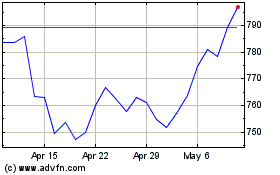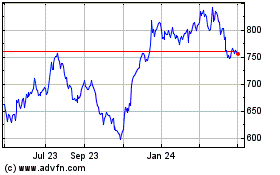New Real Estate Component in S&P Index Could Leave Financial Stocks Adrift
May 12 2016 - 3:01PM
Dow Jones News
By Leslie Josephs
Real-estate stocks are getting their own home in the S&P 500
later this year, a move that could spell trouble in their old
neighborhood.
Real estate shares will split off from financials to become the
11th sector of the S&P 500 starting Sept. 19, according to
S&P Dow Jones Indices. The change could pose a challenge for
funds that focus on financial stocks.
Real-estate investment trusts -- companies that own real estate
but whose shares trade on an exchange like a stock -- have been a
relative bright spot this year, and some have helped limit declines
in the overall financial sector.
Financials are the third-biggest laggard in the S&P 500 this
year, after health care and technology stocks, shedding 3.5% in
2016 compared with the broader market's 0.6% gain.
MSCI U.S. REIT index, which tracks real-estate investment
trusts, is up 5.8% in 2016. REITs, along with real-estate
development and management companies, will be a part of the new
S&P 500 real-estate sector. S&P Dow Jones Indices estimated
in February that the sector would have a roughly 3% weighting.
The change, which was announced last summer, will mark the first
new S&P 500 sector since the current lineup of 10 was launched
in 1999, according David Blitzer, managing director and chairman of
the index committee at S&P Dow Jones Indices. It will separate
real-estate stocks from the financial sector that includes banks
and insurers.
REIT shares have attracted investors this year because they are
big dividend payers. REITs, which own a variety of properties from
single- and multifamily homes to shopping malls, are required to
return most of their profits to shareholders and don't have to pay
taxes on that amount. Mortgage REITs, meanwhile, will remain in the
index's financial sector.
Banks, on the other hand, have been challenged by years of
rock-bottom interest rates, which limits how much they can profit
on loans. The KBW Nasdaq Bank index, which tracks large commercial
U.S. banks, is off 8.4% so far this year.
Investors pulled about $4.8 billion from mutual funds and
exchange-traded funds that focus on financial companies this year
through the end of March, according to Morningstar Inc., compared
with a net $47.8 billion inflow to mutual funds and ETFs broadly in
the first three months of the year.
For increasingly popular passive funds, such as ETFs, those that
follow S&P indexes would lose the contribution of real estate
shares if they are based on the S&P 500's classification
system.
State Street Global Advisors in October launched a special
real-estate sector ETF (XLRE) and a financial-services ETF in
response to the sector split. So far this year, XLRE is up 3.2%.
Its older and broader Financial Select Sector SPDR Fund, XLF, which
includes both real estate and financial stocks, is off 3.3%.
"We're going to follow the changes in the benchmark," said Rich
Powers, head of ETF product management at Vanguard Group, the
second-largest ETF provider by assets. "Latitude to depart very
materially from that is limited."
BlackRock Inc. says its large financial ETF, the $1.1 billion
iShares U.S. Financials ETF, or IYF, follows a different index, so
it would be unaffected by the change. That fund is down 2.4% in
2016.
To be sure, the fortunes of the two sectors could change. The
selloff in financial stocks have made them cheaper. The sector is
trading at 12.4 times the last 12 months' earnings as of Tuesday's
close, according to FactSet, making it the least-expensive sector
in the S&P 500.
"I think financials [aside from REITs] are the most attractive
part of the market," said Peter Stournaras, portfolio manager of
the BlackRock Large Cap Series Funds. He said he's staying away
from REITs and favoring bank stocks partly because more attractive
from a price perspective.
Write to Leslie Josephs at leslie.josephs@wsj.com
(END) Dow Jones Newswires
May 12, 2016 14:46 ET (18:46 GMT)
Copyright (c) 2016 Dow Jones & Company, Inc.
BlackRock (NYSE:BLK)
Historical Stock Chart
From Mar 2024 to Apr 2024

BlackRock (NYSE:BLK)
Historical Stock Chart
From Apr 2023 to Apr 2024
